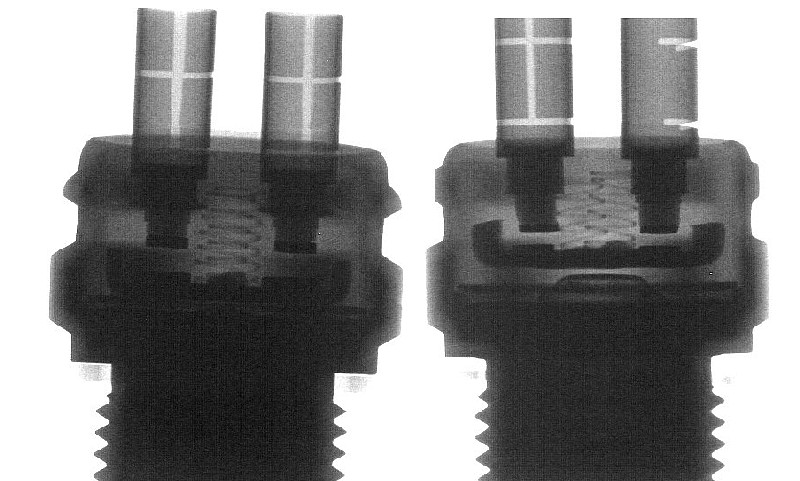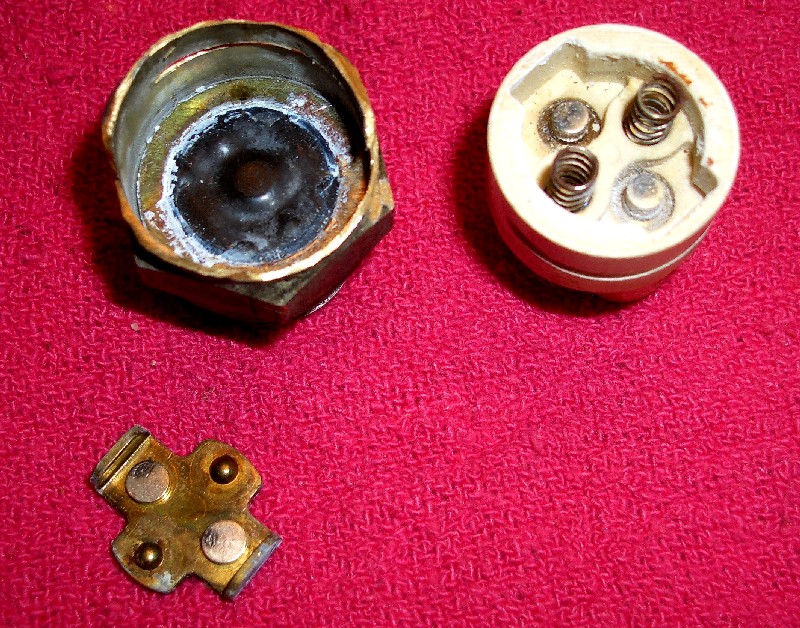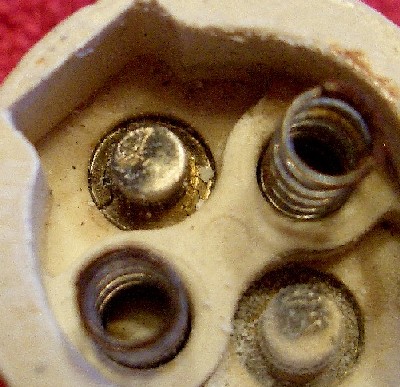|
|

|
Porsche, and the Porsche crest are registered trademarks of Dr. Ing. h.c. F. Porsche AG.
This site is not affiliated with Porsche in any way. Its only purpose is to provide an online forum for car enthusiasts. All other trademarks are property of their respective owners. |
|
|
| davesprinkle |
 Feb 5 2009, 01:52 PM Feb 5 2009, 01:52 PM
Post
#1
|
|
Senior Member    Group: Members Posts: 720 Joined: 13-October 04 From: Berkeley, CA Member No.: 2,943 Region Association: None 
|
OK, I'm now on my third reverse switch, with a consistent problem:
After a few hundred miles, the switch contacts become high-resistance (50 Ohms or so) and the switch leaks tranny fluid, filling up the wiring boot. By the way, the last two switches were brand-new Porsche replacements. I'm running Swepco 201, by the way. Anybody have any suggestions about what might be going on? |
  |
Replies
| jk76.914 |
 May 3 2009, 05:16 PM May 3 2009, 05:16 PM
Post
#2
|
|
Senior Member    Group: Members Posts: 809 Joined: 12-April 05 From: Massachusetts Member No.: 3,925 Region Association: North East States |
Well I installed my new switch from Pelican last weekend. The switch was sealed in a bag marked "Made in Germany", though there were no markings on the switch itself at all anywhere. (Maybe just the bag was made in Germany??).
So I installed the switch, and a brand new pin, and my backup lights worked properly. But the next day, I discovered they were on all the time! In any gear! So I removed the switch, and swapped the sealing washer with the one that was on the old switch. Tricky getting them off, but not too hard with big pliers. The old washer was about 3x the thickness of the new one. This thicker washer spaced the switch further out on the pin, and so now it's worked the way it should for over a whole week! I was wondering why my original switch failed, so first I x-rayed both to see if I could make out any internal differences (old switch on the left, new one on the right). The plastic end of the switch, where the electrical connections are, is invisible in the x-ray. You can make out a ghost of the sealing rings in the threaded butt of the switch, and see how much thicker the original one was compared to the new one. Inside the switch is a rubber diaphram (I learned after cutting it apart- next photos). The rubber keeps the switch contacts separate from the transmission oil side of the switch, and stretches as the pin pushes the contact bridge up to mate with the two contacts on the connector pins. Aside from the gasket thickness and the fact that the new housing is steel vs. the stainless of the old housing, they look like similar internal designs- except that the new one has an obvious metal dome under the contact bridge. The diaphram itself is invisible to x-rays, so it looks like that contact bridge is floating. This design for a switch or relay is called "bridging contacts". It requires 2x the contacts, is expensive, but it is the best way for high current situations, particularly with DC.  I took my old switch apart, and there was the contact bridge, two springs, and rubber diaphram. The contacts look like silver-cad-oxide, which are used for fairly high current and frequent makes-and-breaks. All in all, a very robust design. Zooming in on the contacts in the plastic housing, I think mine failed because of corrosion on the contacts. (Second photo)   So if I had it to do over, I'd start with both the thick and thin gaskets, with a new pin, and see if the switch closes. If it does, I'd leave it at that. If no, I'd remove the thin ring, and leave the thick one and try again. If no-go, then I'd remove the thick one and try the thin one. I'm guessing also that too much movement may stress that rubber diaphram and it may crack and leak with that thin sealing ring. Just a theory, and I'd be glad to x-ray and disassemble for anyone who has a switch that leaks through the terminals if you're interested to prove or disprove it. Jim |
| astronomerdave |
 May 4 2009, 08:35 AM May 4 2009, 08:35 AM
Post
#3
|
|
Member   Group: Members Posts: 69 Joined: 26-January 09 From: Los Angeles, CA Member No.: 9,979 Region Association: Southern California |
I was wondering why my original switch failed, so first I x-rayed both to see if I could make out any internal differences Forget the switch, I want the x-ray machine. Too cool. I thought about building one when I was in school, but I presume you have access to this through work. What's the deal there? |
Posts in this topic
 davesprinkle reverse light switch Feb 5 2009, 01:52 PM
davesprinkle reverse light switch Feb 5 2009, 01:52 PM
 GeorgeRud I've never had one go bad on me, so it seems o... Feb 5 2009, 02:13 PM
GeorgeRud I've never had one go bad on me, so it seems o... Feb 5 2009, 02:13 PM

 davesprinkle
I've never had one go bad on me, so it seems ... Feb 6 2009, 12:07 PM
davesprinkle
I've never had one go bad on me, so it seems ... Feb 6 2009, 12:07 PM
 ejm Maybe the actuating pin is little too long causing... Feb 6 2009, 05:34 AM
ejm Maybe the actuating pin is little too long causing... Feb 6 2009, 05:34 AM
 Joe Ricard That's what I would guess.
As well as the meta... Feb 6 2009, 06:38 AM
Joe Ricard That's what I would guess.
As well as the meta... Feb 6 2009, 06:38 AM

 Drums66
That's what I would guess.
As well as the met... Feb 6 2009, 03:08 PM
Drums66
That's what I would guess.
As well as the met... Feb 6 2009, 03:08 PM
 Dr Evil Did you ever remove the actuating pin? It may be i... Feb 6 2009, 08:53 AM
Dr Evil Did you ever remove the actuating pin? It may be i... Feb 6 2009, 08:53 AM

 davesprinkle
Did you ever remove the actuating pin? It may be ... Feb 6 2009, 12:10 PM
davesprinkle
Did you ever remove the actuating pin? It may be ... Feb 6 2009, 12:10 PM

 Dr Evil
Did you ever remove the actuating pin? It may be... Feb 6 2009, 01:31 PM
Dr Evil
Did you ever remove the actuating pin? It may be... Feb 6 2009, 01:31 PM

 davesprinkle
[quote name='davesprinkle' post='1130912' date='F... Feb 6 2009, 01:35 PM
davesprinkle
[quote name='davesprinkle' post='1130912' date='F... Feb 6 2009, 01:35 PM
 kconway Vent is oposite side of the case top just before t... Feb 6 2009, 12:47 PM
kconway Vent is oposite side of the case top just before t... Feb 6 2009, 12:47 PM
 Demick I've had the reverse switch leak through the s... Feb 6 2009, 03:49 PM
Demick I've had the reverse switch leak through the s... Feb 6 2009, 03:49 PM

 davesprinkle
I've had the reverse switch leak through the ... Feb 6 2009, 06:26 PM
davesprinkle
I've had the reverse switch leak through the ... Feb 6 2009, 06:26 PM
 ejm
If you remove it make note of where the vent hol... Feb 6 2009, 05:32 PM
ejm
If you remove it make note of where the vent hol... Feb 6 2009, 05:32 PM

 astronomerdave
Pulled the switch and pin out of a box at the sho... Apr 9 2009, 03:07 AM
astronomerdave
Pulled the switch and pin out of a box at the sho... Apr 9 2009, 03:07 AM

 astronomerdave :bump:
Does anyone know the position of the pin ... Apr 15 2009, 03:43 PM
astronomerdave :bump:
Does anyone know the position of the pin ... Apr 15 2009, 03:43 PM
 Maltese Falcon I've had 2 new ones go bad, all leaking at the... Feb 7 2009, 04:28 PM
Maltese Falcon I've had 2 new ones go bad, all leaking at the... Feb 7 2009, 04:28 PM

 davesprinkle
I've had 2 new ones go bad, all leaking at th... Feb 7 2009, 07:40 PM
davesprinkle
I've had 2 new ones go bad, all leaking at th... Feb 7 2009, 07:40 PM
 ssstikircr I could just be a bad batch when those were made. ... Feb 7 2009, 05:43 PM
ssstikircr I could just be a bad batch when those were made. ... Feb 7 2009, 05:43 PM
 kwales Seals,
We don;t need no stinking seals..
Probabl... Feb 7 2009, 05:48 PM
kwales Seals,
We don;t need no stinking seals..
Probabl... Feb 7 2009, 05:48 PM
 Dr Evil Dave, I'll sell you a used one for cheap ;) PM... Feb 7 2009, 08:04 PM
Dr Evil Dave, I'll sell you a used one for cheap ;) PM... Feb 7 2009, 08:04 PM
 charliew I wonder if the same switch is on the type 1 vw tr... Apr 9 2009, 09:19 AM
charliew I wonder if the same switch is on the type 1 vw tr... Apr 9 2009, 09:19 AM
 jk76.914 This is VERY timely.
Mine did the same thing. Sa... Apr 19 2009, 09:35 AM
jk76.914 This is VERY timely.
Mine did the same thing. Sa... Apr 19 2009, 09:35 AM

 davesprinkle
This is VERY timely.
Mine did the same thing. S... Apr 19 2009, 10:23 AM
davesprinkle
This is VERY timely.
Mine did the same thing. S... Apr 19 2009, 10:23 AM

 astronomerdave
You should be careful when purchasing a new switc... Apr 19 2009, 01:05 PM
astronomerdave
You should be careful when purchasing a new switc... Apr 19 2009, 01:05 PM
 perrin1097
OK, I'm now on my third reverse switch, with ... Apr 19 2009, 10:29 AM
perrin1097
OK, I'm now on my third reverse switch, with ... Apr 19 2009, 10:29 AM
 charliew Ok when things go to hell after you've been me... Apr 19 2009, 01:07 PM
charliew Ok when things go to hell after you've been me... Apr 19 2009, 01:07 PM

 astronomerdave
Ok when things go to hell after you've been m... Apr 19 2009, 01:12 PM
astronomerdave
Ok when things go to hell after you've been m... Apr 19 2009, 01:12 PM
 charliew I'm talking about the amount of shift movement... Apr 19 2009, 01:22 PM
charliew I'm talking about the amount of shift movement... Apr 19 2009, 01:22 PM

 Cap'n Krusty
I'm talking about the amount of shift movemen... May 3 2009, 07:38 PM
Cap'n Krusty
I'm talking about the amount of shift movemen... May 3 2009, 07:38 PM
 Dr Evil Thats just plain cool! Well done :) May 3 2009, 06:20 PM
Dr Evil Thats just plain cool! Well done :) May 3 2009, 06:20 PM
 davesprinkle Good work on this investigation, jk.
I'm surp... May 3 2009, 06:46 PM
davesprinkle Good work on this investigation, jk.
I'm surp... May 3 2009, 06:46 PM
 jk76.914 The rubber diaphram is in the 33 year old switch. ... May 3 2009, 07:01 PM
jk76.914 The rubber diaphram is in the 33 year old switch. ... May 3 2009, 07:01 PM
 charliew Why not just put the tranny in reverse with the sw... May 3 2009, 07:25 PM
charliew Why not just put the tranny in reverse with the sw... May 3 2009, 07:25 PM

 jk76.914
Why not just put the tranny in reverse with the s... May 3 2009, 08:33 PM
jk76.914
Why not just put the tranny in reverse with the s... May 3 2009, 08:33 PM
 charliew You are correct in what you post about the more re... May 4 2009, 09:22 AM
charliew You are correct in what you post about the more re... May 4 2009, 09:22 AM  |
2 User(s) are reading this topic (2 Guests and 0 Anonymous Users)
0 Members:

|
Lo-Fi Version | Time is now: 31st October 2024 - 07:27 PM |
Invision Power Board
v9.1.4 © 2024 IPS, Inc.








